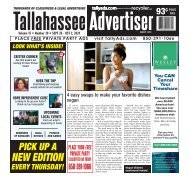Create successful ePaper yourself
Turn your PDF publications into a flip-book with our unique Google optimized e-Paper software.
THETRUCKER.COM<br />
b Response from page 10 b<br />
down our society, it shut down whole industries.<br />
Oil and gas seemed like it stopped overnight,”<br />
said Bears, who was forced to lay off<br />
several of his employees as a result.<br />
“I had to scramble and try to find different<br />
avenues to diversify the company,” he said, noting<br />
that he’s shifted to hauling commodities, such<br />
as corn and wheat, as well as consumer products<br />
sold by Amazon. The rise in remote working, too,<br />
has affected the products Bears’ company has<br />
been transporting during the pandemic.<br />
“Aside from commodities and household<br />
goods, a lot of people are moving from bigger<br />
cities to smaller states or cities to try to<br />
save money or downsize their homes,” he said.<br />
“We’ve pulled a lot of moving trailers.”<br />
Bears is hopeful that his business will rebound<br />
as the pandemic subsides, but he’s not<br />
sure when that will happen.<br />
In the meantime, driving across the country<br />
in 2020 has shown him the same reality Byrd<br />
and Lopez noticed on their routes: Concern<br />
over the virus varies dramatically, depending<br />
on where you stop.<br />
“You could go up into Wyoming or Montana<br />
or South Dakota in the middle of the pandemic<br />
and still sit down in a restaurant and eat a meal,”<br />
Bears said. “It seems like there’s a line drawn in<br />
the sand when you hit Colorado and the Southwest.<br />
Everything was totally shut down. You<br />
couldn’t even get fuel without a mask.”<br />
Story by Kathryn Palmer, Wyoming Tribune<br />
Eagle 8<br />
THE TRUCKER NEWS SERVICES<br />
SEA<strong>TT</strong>LE — Because of increased<br />
detour traffic caused by maintenance and<br />
repair work on area bridges, the Seattle<br />
Department of Transportation (SDOT) is<br />
asking the public to avoid the Low Bridge<br />
linking Seattle and West Seattle, leaving the<br />
route clear for emergency vehicles, transit<br />
and heavy freight. As of Jan. 11, unauthorized<br />
use of the bridge could result in a $75<br />
citation for each trip across the structure,<br />
according to a Dec. 29 statement from<br />
SDOT.<br />
Alternate routes for those traveling to and<br />
from West Seattle by car include the First<br />
Ave. South Bridge or South Park Bridge. The<br />
Low Bridge may be used by those who are<br />
riding transit, in a vanpool, walking, rolling,<br />
riding a scooter or biking.<br />
In addition to updating markings on the<br />
route, SDOT is adjusting signal timing, improving<br />
road signs and working with nearby<br />
communities to prioritize projects that will<br />
reduce the impact of increased detour traffic,<br />
prioritizing transit connections to and<br />
from West Seattle, building new bicycle<br />
projects, and establishing and improving<br />
detour routes.<br />
According to a statement released by<br />
SDOT, the West Seattle High-Rise Bridge<br />
Nation January 15-31, 2021 • 11<br />
Seattle DOT urges public to avoid Low Bridge, leave route<br />
clear for emergency vehicles, transit and heavy freight<br />
Courtesy: Tim Durkan<br />
Keeping traffic moving on Seattle’s Low<br />
Bridge is important because it allows<br />
safe and timely passage for emergencyresponse<br />
vehicles, transit and freight.<br />
carried significantly more vehicles because<br />
it has seven lanes compared to the two lanes<br />
on the Low Bridge. If all the former traffic<br />
from the High-Rise Bridge attempts to use the<br />
Low Bridge, it will create severe congestion<br />
and long traffic back-ups, blocking access for<br />
emergency vehicles.<br />
Based on data analysis, SDOT has identified<br />
and placed a cap on the number of<br />
vehicles that are allowed to use the Low<br />
Bridge daily from 5 a.m. to 9 p.m. since the<br />
closure of the West Seattle High-Rise Bridge<br />
in March 2020. Vehicle restrictions will be<br />
enforced with the help of traffic cameras,<br />
which were installed Dec. 10; the cameras are<br />
designed to record license plates only.<br />
The automated photo enforcement system<br />
was activated Jan. 11, 2021; unauthorized<br />
Low Bridge users will be subject to a $75 citation<br />
for every trip across the bridge. Citations<br />
will be sent to the mailing address of the<br />
registered owner of the unauthorized vehicle<br />
that crosses the Low Bridge.<br />
From 5 a.m. to 9 p.m. each day, the following<br />
are authorized to use Seattle’s Low<br />
Bridge:<br />
• Emergency vehicles;<br />
• Transit vehicles (King County Metro<br />
buses and school buses);<br />
• Freight vehicles;<br />
• People who are walking, rolling, using a<br />
scooter or biking;<br />
• Employer shuttles;<br />
• Vanpools; and<br />
• Pre-authorized vehicles.<br />
Personal vehicles (including motorcycles),<br />
taxis and ride-hail app vehicles (such as Uber<br />
and Lyft) are allowed to use the Low Bridge<br />
at night, from 9 p.m. to 5 a.m. daily. 8<br />
tHanK yoU to flatbed truck drivers and all<br />
essential workers on the front line of covid-19<br />
• Local, Regional & OTR<br />
• Percentage Paid Weekly<br />
• Great Home Time and<br />
Benefits including<br />
Paid Holidays<br />
apply online now<br />
www.thetrucker.com/pii<br />
866.819.8913<br />
• Ask About Our Pay<br />
Guarantee & Vacation<br />
paid training program for<br />
company drivers

















